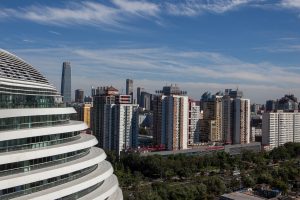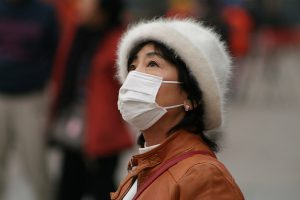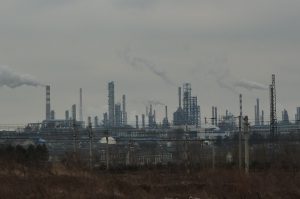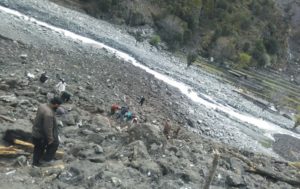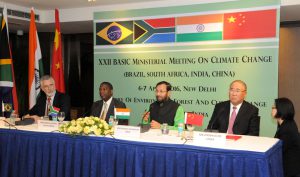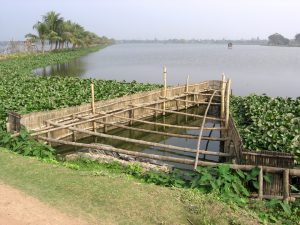China’s government hopes that co-ordinated development of Beijing and Tianjin with the neighbouring province of Hebei will help ease congestion, cut pollution, alleviate the soaring cost of living in the capital, spread prosperity and create new jobs.
But a new report suggests that the Beijing-Tianjin-Hebei (Jing-Jin-Ji) region’s industry and energy mix needs to shift decisively if it is to meet new national air pollution standards of 35 micrograms per cubic metre (µg/m3) by 2030.
See also: Can China meet its 2017 air quality goals?
Last October, influential academic Pan Jiahua told chinadialogue that Jing-Jin-Ji, a metropolitan region numbering 110 million people linked by new railways and roads (along the lines of the Pearl River Delta) will exert even greater pressure on water and land resources in the parched and heavily populated area.
China’s economic blueprint from now until the end of 2020, the 13th Five-Year Plan which was published on March 17, has for the first time included a specific target to cut levels of PM2.5 (the harmful fine particulate matter that causes air pollution) by 25%.
The report – named How to achieve air quality targets in Beijing-Tianjin-Hebei: Scenarios for meeting PM2.5 standards – was produced by the National Development and Reform Commission’s Energy Research Institute, Tsinghua University’s School of the Environment, and the China Clean Air Alliance.
Xie Hongxing, director of the CCAA, said: “This is the first time a roadmap to PM2.5 compliance has been produced based on actual data.”
The report modelled changes in PM2.5 levels under three scenarios. The first involves a baseline scenario assuming circumstances prevalent in 2013 would continue (one where energy consumption and emissions stay the same).
The second envisages an outcome where technology is optimised to cut PM2.5 pollution at source, such as scrubbing and filtering technology in industrial plants.
The third scenario, meanwhile, would require much tougher enforcement of pollution curbs, where changes are made to industry and energy production, and transportation emissions are dealt with rigorously.
The results showed that even applying the best available technology won’t help the northern super-region meet a 35 µg/m3 target, although it could get close, perhaps reaching 40 µg/m3 at best.
The most ambitious scenario sketched out by ERI would include root-and-branch upgrades and improvements to industrial pollution control equipment, shutdowns of polluting furnaces, and reductions of emissions of volatile organic compounds.
VOCs are released as a by-product by vehicles and the production of chemicals and solvents and a are major cause of air pollution in northern China.
Even with these changes, regional PM2.5 levels would only drop to only 40 µg/m3. This remains higher than the national target of 35 micrograms. Only the robust scenario could ensure that 40 µg/m3 is met across the region.
To get to 40 µg/m3 or below, steel, concrete and plate glass sectors in Hebei and Tianjin would have to stop growing, and perhaps even shrink. For example steel production in Hebei would be limited to 120 million tonnes annually, with concrete production restricted to 70 million tonnes.
These hypothetical ‘limits’ would involve production cuts of 35% for steel (from 185 million tonnes in 2014) and also 35% for concrete (down from 107 million tonnes) respectively, according to figures from the National Bureau of Statistics.
Under a 40 µg/m3 scenario, the amount of coal in the energy mix would be cut from the current figure of over 70% to about 30%. Electricity from natural gas, renewables and imports would all need to grow at three to four times current rates. In total, this would deliver a cut in carbon emissions of 20% on the 2013 baseline.
Wang Lisha of the Clean Air Alliance told chinadialogue that the scenarios were based on evaluations of current policies and technologies. For example, the technologies to reduce emissions from transportation and industry exist – it is just a matter of whether these can be applied quickly and forcefully enough.
Changes to the industrial and energy structure, meanwhile, are likely to be determined locally according to economic circumstances.
Disparities
There are huge disparities within the Beijing-Tianjin-Hebei region, and the difficulties incurred will differ accordingly. Statistics from 2014 show that Beijng’s service sector accounted for 80% of its GDP, compared to 50% in Tianjin and only 37% in Hebei.
Dominance by a single sector makes local governments less able to adapt to low-carbon choices and speed up industrial restructuring, said Jiang Kejuan, a researcher with the Energy Research Institute (ERI) and one of the authors of the report.
“But the service sector includes healthcare, finance, technological services – overall there is plenty of room for expansion [of non-industrial activities].”
Although Hebei has managed to deliver some successes in efforts to combat smog (figures from the provincial government show 2015 PM2.5 levels down 28.7% on 2013), cutting production or closing down firms has stoked unemployment in a province that has struggled to develop technology-based industries.
Priorities
Jiang said that it is not possible to simply reduce coal output overnight, while the ERI points to the three parts of the region as having distinctly different economic roles and priorities.
Beijing, as the capital, will develop urban functions serving China and international markets: higher education, technology, Internet services and biotech.
Tianjin will focus on industry and services such as high-end manufacturing, the commercialisation of technology, and also capitalise on its status as a port city.
Hebei will develop local services and provide rural tourism and agricultural products to Tianjin and Hebei, as well as building up areas of housing that would be less crowded and cheaper than Beijing.
Co-ordinated action with the areas surrounding the Beijing-Tianjin-Hebei region is essential, the report states. Otherwise, even in the most robust scenario, air quality targets won’t be met.
